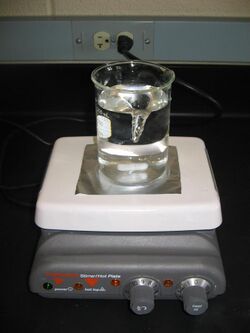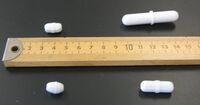Organization:Magnetic stirrer
 A stir bar mixing a solution on a combined hot-plate magnetic-stirrer device. The left knob controls the stirring rate and the right knob controls heating. | |
| Other names | Magnetic mixer |
|---|---|
| Uses | Liquid mixing |
| Inventor | Arthur Rosinger |
| Related items |
|
A magnetic stirrer or magnetic mixer is a laboratory device that employs a rotating magnetic field to cause a stir bar (or flea) immersed in a liquid to spin very quickly, thus stirring it. The rotating field may be created either by a rotating magnet or a set of stationary electromagnets, placed beneath the vessel with the liquid.
Magnetic stirrers are often used in chemistry and biology, where they can be used inside hermetically closed vessels or systems, without the need for complicated rotary seals. They are preferred over gear-driven motorized stirrers because they are quieter, more efficient, and have no moving external parts to break or wear out (other than the simple bar magnet itself). Magnetic stir bars work well in glass vessels commonly used for chemical reactions, as glass does not appreciably affect a magnetic field. The limited size of the bar means that magnetic stirrers can only be used for relatively small experiments, of 4 liters or less. Stir bars also have difficulty in dealing with viscous liquids or thick suspensions. For larger volumes or more viscous liquids, some sort of mechanical stirring is typically needed.
Because of its small size, a stirring bar is more easily cleaned and sterilized than other stirring devices. They do not require lubricants which could contaminate the reaction vessel and the product. Magnetic stirrers may also include a hot plate or some other means for heating the liquid.
History
Arthur Rosinger of Newark, New Jersey, U.S. obtained US Patent 2,350,534, titled Magnetic Stirrer on 6 June 1944, having filed an application therefore on 5 October 1942.[1] Mr. Rosinger's patent includes a description of a coated bar magnet placed in a vessel, which is driven by a rotating magnet in a base below the vessel. Mr. Rosinger also explains in his patent that coating the magnet in plastic or covering it with glass or porcelain makes it chemically inert.
The plastic-coated bar magnet was independently invented in the late 1940s by Edward McLaughlin, of the Torpedo Experimental Establishment (TEE), Greenock, Scotland, who named it the 'flea' because of the way it jumps about if the rotating magnet is driven too fast.
An even earlier patent for a magnetic mixer is US 1,242,493, issued 9 October 1917 to Richard H. Stringham of Bountiful, Utah, U.S. Mr. Stringham's mixer used stationary electromagnets in the base, rather than a rotating permanent magnet, to rotate the stirrer.
The first multi-point magnetic stirrer was developed and patented by Salvador Bonet of SBS Company in 1977. He also introduced the practice of noting the denomination of stirring power in "liters of water", which is a market standard today.
A heating element, whose power may range from a few hundred to a few thousand watts, can also be incorporated to the stirrer to allow the reaction flask to be heated and stirred at the same time. The maximum reachable fluid temperature depends on the size of the flask, the quantity of solution to be heated, and the power of the heating element.
Stir bars
A stir bar is the magnetic bar placed within the liquid which provides the stirring action. The stir bar's motion is driven by another rotating magnet or assembly of electromagnets in the stirrer device, beneath the vessel containing the liquid.[2] Stir bars are typically coated in PTFE, or, less often, in glass; the coatings are intended to be chemically inert, not contaminating or reacting with the reaction mixture they are in.[2] Glass coatings are used for liquid alkali metals (except lye, which will eat through glass) and alkali metal solutions in ammonia.[3]
They are bar shaped and often octagonal in cross-section (sometimes circular), although a variety of special shapes exist for more efficient stirring. Many stir bars have a pivot ring around the center on which they rotate. The smallest are only a few millimeters long and the largest a few centimeters. A stir bar retriever is a separate magnet on the end of a long stick (usually coated with PTFE) which can be used to remove stir bars from a vessel.[2]
See also
- Shaker (laboratory)
- Stirring rod
- Static mixer
References
- ↑ Arthur Rosinger (June 6, 1944). "Magnetic Stirrer". United States Patent Office. http://www.google.com/patents/about?id=3CxTAAAAEBAJ&dq=US+Patent+2,350,534. Retrieved 16 February 2013.
- ↑ 2.0 2.1 2.2 "Stir Bars". University of Colorado at Boulder. http://orgchem.colorado.edu/Technique/Equipment/Benchequip/Stirbar.html. Retrieved 16 February 2013.
- ↑ S. Girolami, Gregory; B. Rauchfuss, Thomas; J. Angelici, Robert (1999-08-01). Synthesis and Technique in Inorganic Chemistry: A Laboratory Manual (3 ed.). University Science Books. p. 87. ISBN 978-0-935702-48-4. https://books.google.com/books?id=3fJGLwvjbRAC&pg=PA87. Retrieved 2013-04-23.
External links
- Short video of a homemade stir plate. Creative Commons Attribution license (reuse allowed).
fr:Agitateur (chimie)
 |



